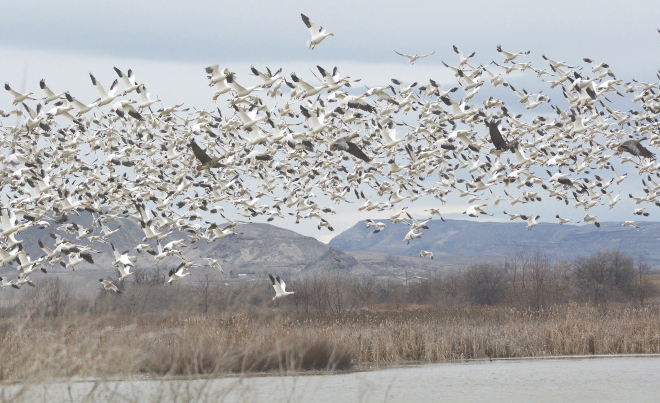
IDFG Public Information Specialist
Welcome to 2018 and all it will bring for outdoors folks. Many are looking forward to hunting, and even if you’re not a hunter, you’re probably a wildlife watcher, so there’s lots of cool things in the coming months.
It’s tricky to talk about the upcoming hunting season while it’s still in progress. January 1 is technically the start of the new hunting season, so don’t forget to buy your 2018 license, but it’s also continuation of 2017 for a variety of hunts.
Let’s look at what’s currently available, and then what lies ahead.
As most hunters know, Idaho has some generously long bird seasons, so shotgunners can continue to pursue waterfowl and upland game birds. Waterfowl hunters should take note of extended seasons for white-fronted geese and snow geese, which last into February and March, respectively. You can see details in the waterfowl rules booklet.
Predator hunters can take advantage of animals being at lower elevations, and snow provides easier tracking, and pelts are in prime condition.
Those aren’t the only things that hunters focus on during winter. Most are involved in hunting year round, even if they don’t have a gun or bow in hand and a tag in their pockets. We’re watching wildlife and gearing for upcoming seasons.
So far, weather is pretty mild in comparison with last winter, but there’s still a lot winter to get through. It’s a busy time of year for Fish and Game crews because they’re monitoring big game herds by flying and counting animals and trapping and collaring young deer and elk so they can see how many survive winter.
Winter is a double-edged sword for big game herds because the habitat they rely on needs snow and rain to grow forage and sustain animals, but like last winter showed, there can be too much of a good thing.
Winter is a critical test for fawns and calves. If they survive their first winter, they’re likely to survive many more. Long-term averages show about 57 percent of mule deer fawns will survive their first winter, but for adults it’s typically over 95 percent. Because elk are larger animals, calves usually survive at higher rates, but getting through the first winter isn’t a gimme for them, either.
Fish and Game collars hundreds of young deer and elk and adult females every winter so they can monitor their survival and adjust hunting seasons in accordance. Biologists have been doing it for 20 years, and it has provided valuable insight into how herds fare each winter.
With a little luck from the weather, we may see our mule deer herds bounce back, or at least, sustain their current levels. Idaho’s current elk boom is likely to continue barring something catastrophic.
While winter has just started, it’s not too soon to start thinking about spring. Seems like we barely get the shotguns put away from waterfowl season and it’s time to break them out again for turkey season in April.
I also mentioned wildlife watching, and that’s another cool opportunity for outdoors folks. Most big game animals are down on winter range, which makes them easily visible, but people should always respect how important it is to leave animals undisturbed. There are many places around the state you can drive and park and spot them with binoculars or spotting scopes.
There’s also some amazing waterfowl watching in late winter and early spring when flocks of snow and white-fronted geese migrate through Idaho on their northern journey. The Fort Boise Wildlife Management Area and Roswell Marsh near Parma are both amazing places to see (and hear) them. It’s also a good place to see large flocks of turkeys, but tags for them are limited to controlled hunts, so don’t forget to apply in February.
April general turkey hunts provide an opportunity to get back in the woods with a 2018 tag in your pocket. I like to hunt turkeys like big game and get off of the valley floors and scour the ridges and woods for birds. It gives me a chance to hike and see animals returning to the mountainsides as the snow recedes.
It’s also time for spring bear hunting. Many hunters set up bait stations and see numerous bears before deciding if they will take one, so it’s another cool way to watch wildlife and sort of catch-and-release hunting. There are rules for setting up bait sites, and you can see them on pages 67-68 of the big game rules booklet.